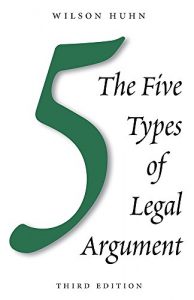Huhn demonstrates that there are five different types of legal arguments (based on text, intent, precedent, tradition and policy), and through myriad examples this book teaches law students, lawyers, and judges how to identify, create, attack, and evaluate each type of argument. The book contains useful advice and illustrations on how to weave the different types of arguments together to make them more persuasive. The third edition of the book adds a chapter on the role that reasoning by analogy plays in resolving difficult cases and in the development of the law.
“I found The Five Types of Legal Argument to be invaluable because it succinctly breaks down legal analysis. At first, reading judicial opinions, especially with majority and dissenting opinions, can be a dizzying experience. But when you break down the arguments you learn to spot appeals to different types of reasoning. The reward is two-fold: First, you can more easily understand judicial opinions and can criticize or appreciate them on a more sophisticated level. Second, the five types of legal arguments become a checklist of tools that you can invoke to make persuasive legal arguments of your own.” Bryce Landier, former law student
“The Five Types of Legal Argument contains two of the top three most valuable pages that I have read during my time in law school.” Whit Pierce, law student
“The Five Types of Legal Argument will help you shift the way you read from simply understanding and memorizing legal texts to critically analyzing and interpreting the text and the arguments made within the text. I wish I read this book during my 1L year.” Kathleen Rose, law student
“This book will help you read, it will help you write, and it will help you think clearly about the arguments that are made in legal discourse.” Jonathan Williams, law student
“In law school, professors always tell us not to focus on the trees, but to step back and see the forest when analyzing legal issues. This book certainly furthers that well-reasoned approach.”Amanda Johnson, law student
“The book serve[s] as a fine introduction to legal analysis and indicate to students the importance of identifying the categories of legal argument they encounter.” Ben Wiles, law student



